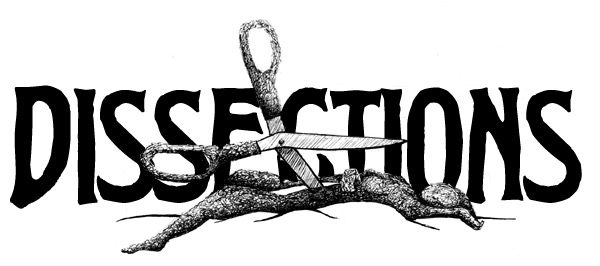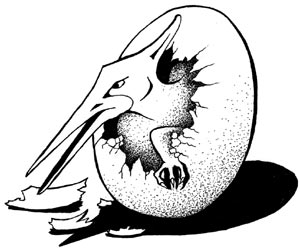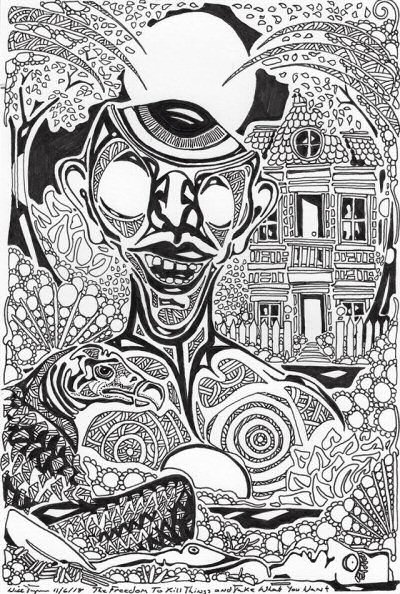[an error occurred while processing this directive]



Artwork: The Freedom to Kill Things and Take What You Want by Will Jacques
Spinning
Rob Bliss
The killer asks: “How much to go on this ride?”
The man standing at the base of the blue steel steps, toe leather creaking as he thinks about the price, responds, “Two tickets.”
A carny. Thin skin, alcoholic red, cheekbones made of wood, patches of leather cut with lines sliced in by sunlight. Red veins in yellow cheese: the carny’s eyes. Nose like a fungus. One bulbous eye aims away toward the crowd and the cotton candy stand, the air smells of popcorn, synthetic butter, and rising yeast – the carny’s nostrils are as wide as cherries.
Reminds the killer of the girl he sliced. Squeezed an aureole until it was a purple plum. She wore a rainbow halter top, and the carny wears a red and blue plaid shirt that stinks of tobacco. His skin seeps a perpetual sweat, like pig fat. The girl had a small nose peppered with freckles and tiny black and blonde hairs set deep in the caverns of her nostrils. Not many people know that even pretty girls have nose hairs.
A chain tipped by a brass clip polished by chapped finger and thumb is unlatched and the carny lets the killer ascend the stairs, from metal to wood, boards of worn blue paint fringe the cars, closing off all gaps, hiding the clockworks below. The years stained permanently black, coagulated by clots of grease won’t be seen, and once the screaming starts, the grind of metal will mute.
The cars sit low and are slashed with stripes of glowing paint and splashed with glitter. When the sun goes down and the carnival goes on, the spinning will still be seen as a blur of light, and the screams will spin their howls in the darkness, their natural environment.
The killer treads the boards up into the darkened heights of the tilted carousel to find a car in which he can ride alone. He is solitude personified. Has been since the death of the final member of his small, dying family. What was his mother’s name? Do killers have mothers? In his plastic car, he stares out of the darkness at the carny, thinking how wonderful a victim the crooked man would’ve been.
And into the other cars file youth. Rushing in like fresh water, a tide flowing, to ebb when the ride dies. Some would think it strange that he was never attracted to the butchering of the young. Don’t all killers crave to destroy that which they themselves had lost? If he had no youth, then why should others? Wasn’t that the reasoning? Doctors and law enforcement would agree.
But he did have a childhood, as serene as Monarch butterflies
flittering over a field of wild flowers. He tortured no animals; in
fact, they adored him. But they avoided his father – the man who
taught the lesson that if you have no need of something then it was
necessary to get rid of it. Even a life. Kill the cat instead of giving
it freedom, and tumble its kittens into a burlap sack with a stone and
drive the writhing sack to the neighbour who has agreed to let one of
the many ponds on his acreage be a tomb. There is no communication in
the natural order; death must happen, so spake the Father.
The killer killed the old and, thus, was able to see himself as an entity
of goodness, leaving the young to enjoy their youth. The old, the ugly
– the limbs made of poorly pasted sticks, bamboo shins and cracked
stones for knees. Hair made of straw, woven over bald patches, burned
by seaside sunlight, pates spotted like toadstools – people as
amphibians. He once watched his cousin – the violent one –
kill frogs with a slingshot, and revel at each paralysis, the wide-eyed,
slick-back thing – just a thing – floating white belly-up.
He was offered the sling, but couldn’t kill. An ugly animal was
beautiful; an ugly human was an evolutionary error. Only the ugly, the
gorgons and tumorous, the hideous lechers and leering hermaphrodites
– he acquired the murderous scruples of Raskolnikov to better
himself.
Beauty in youth surrounded him in carnival cars, back and front. He
lowered the silver bar onto his lap, didn’t wait for it to click,
didn’t care if he flew out. Every child dreamed of being able
to fly; he dreamed of wings so often that he had to check his arms for
feathers. What would the shrink say: the child who longs for freedom
has well-measured the dimensions of his adolescent prison. Every killer
starts in a cage, gives birth to a new self while immobilized, and is
terrified to leave it; he must kill to get out.
He tried to run away from home once, but his Father – supine on
the sofa, unmoving, a stone – dug his wallet from his rear pocket
(who keeps their wallet on them when at home – a man who worships
his money and needs to keep his god close) and offered his son a fifty
dollar bill. The son had never seen one before, could only assume it
wasn’t real. Had it been a five, the boy would’ve run and
lived in the forest behind their farm house. But since money confused
him, he untied the bindle from the branch, put his toys back in the
toy box – in the shape of a giant frog’s head – and
cried in his prison. Freedom was terrifying; he would never try to run
away again. Every victim reminded him of home.
Not the carny, but the better voice of an invisible – and likely
handsome – man in a booth announced over speakers positioned high
on the proscenium arch of the ride, wings of music and a barker’s
lyrical temptation: “Does everybody wanna go faster!”
And they screamed around the killer. An endless police siren wailed
as the music’s beat rose in volume and tempo – the speeding
of pulses in the seats. Centrifugal force pushing lovers against each
other, enemies and friends unable to pry themselves apart using the
silver bar, the spin creating a false magnetism. Bare thighs squeaked
on plastic and the blue boards sped by like a crooked snake.
“Does everybody wanna go faster!”
Screams amidst laughter and klaxons, the faces of those looking on –
crossed arms, hands digging into popcorn boxes or plucking hair off
spun sugar – the static, the unmoving – the faces blurred.
The killer knew they would. Ugliness washed away, smeared by speed,
in this place of all places. A fair, one of the few Edens his parents
took him to, where there was no death or toil or depression. Sorrow
led too often to leaps of imagination; when something dies – an
aunt, grandparents, a sister – worlds are born in the mind, coalesce
and bloat their boundaries. Monsters congregate and swarm, the ugly
encroach – they chant and stamp and clang together their hooks
and scratch talons against fangs, pitchforks:
“We are the killers of a beautiful life! All beauty must die!”
Every grandparent is beautiful, every aunt and uncle with peppermint
pockets and packs of unopened hockey cards, every sister – once
a nemesis, but after death and decades of the brother persisting to
live – also transforms into the beauty of youth. Dead before twenty,
cancer rot, forehead a slab of chalk, the skull of white fuzz, knee
and elbows like balls of stone, red threads in the yellow fat of her
eyeballs. A mouth cracked above her chin, nostrils widened to dark dimes,
temples sunken to bruised pits. Tissue-thin nightie fell across the
washboard of her ribs, pelvis cradle jutting upward like dinosaur bones
unearthed by a slow breeze. Quick decay eats her last months; she is
dust with a fading heartbeat.
Death traumatizes memory, and the killer finally feels sorry for what
he has become. Rainbow girl – funny now to realize after all these
years – looked exactly like his sister. But all sisters must surely
be dead; therefore the rainbow’s colours had to be stained monochromatic
by blood.
The carny stood at the gate, chain clipped back to its bar to prevent
those held in stasis from entering the spin. Horns of hair grew off
his head in the wind; he watched the watchers.
Despite the press of the magnetism of bodies and force, the killer was
able to pull the gun from an inside pocket. Speed camouflaged his movements,
and the songs and screams masked the gunshot that took off the top of
his head.
Blood and bone fell as rain across the gleeful young, and the killer
only sagged in his seat when the two-ticket ride wound down and came
to a dizzying halt.
